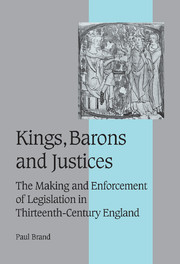Book contents
- Frontmatter
- Contents
- List of tables
- Preface
- List of abbreviations
- INTRODUCTION
- Part I Politics and the legislative reform of the common law: from the Provisions of Westminster of 1259 to the Statute of Marlborough of 1267
- Part II Beyond politics: the enforcement and interpretation of the Statute of Marlborough in the courts, 1267–1307
- Chapter 8 CONTRA FORMAM FEOFFAMENTI: THE STATUTORY ACTION FOR TENANTS CONTESTING LIABILITY TO SUIT OF COURT AFTER 1267
- Chapter 9 OTHER MECHANISMS FOR THE ENFORCEMENT OF CHAPTER 9; OTHER REFORMS AFFECTING THE LORD–TENANT RELATIONSHIP
- Chapter 10 REFORMS IN THE CRIMINAL JUSTICE SYSTEM
- Chapter 11 REFORMS IN THE PROCEDURES OF THE ROYAL COURTS
- Chapter 12 THE EXTENSION OF EXISTING REMEDIES
- Chapter 13 ENFORCING THE ACCOUNTABILITY OF SOCAGE GUARDIANS
- Chapter 14 CONTROLLING THE USE OF DISTRAINT
- Chapter 15 REMEDYING ABUSES IN THE OPERATION OF LOCAL COURTS
- Chapter 16 CONCLUSIONS
- Appendix I TEXT AND TRANSLATION OF THE PROVISIONS OF WESTMINSTER OF 1259
- Appendix II TEXT AND TRANSLATION OF THE PROVISIONS OF WESTMINSTER AS REISSUED IN 1263 AND 1264
- Appendix III TEXT AND TRANSLATION OF THE STATUTE OF MARLBOROUGH OF 1267
- Bibliography
- Index
- Cambridge Studies in Medieval Life and Thought Fourth series
Chapter 9 - OTHER MECHANISMS FOR THE ENFORCEMENT OF CHAPTER 9; OTHER REFORMS AFFECTING THE LORD–TENANT RELATIONSHIP
Published online by Cambridge University Press: 16 June 2009
- Frontmatter
- Contents
- List of tables
- Preface
- List of abbreviations
- INTRODUCTION
- Part I Politics and the legislative reform of the common law: from the Provisions of Westminster of 1259 to the Statute of Marlborough of 1267
- Part II Beyond politics: the enforcement and interpretation of the Statute of Marlborough in the courts, 1267–1307
- Chapter 8 CONTRA FORMAM FEOFFAMENTI: THE STATUTORY ACTION FOR TENANTS CONTESTING LIABILITY TO SUIT OF COURT AFTER 1267
- Chapter 9 OTHER MECHANISMS FOR THE ENFORCEMENT OF CHAPTER 9; OTHER REFORMS AFFECTING THE LORD–TENANT RELATIONSHIP
- Chapter 10 REFORMS IN THE CRIMINAL JUSTICE SYSTEM
- Chapter 11 REFORMS IN THE PROCEDURES OF THE ROYAL COURTS
- Chapter 12 THE EXTENSION OF EXISTING REMEDIES
- Chapter 13 ENFORCING THE ACCOUNTABILITY OF SOCAGE GUARDIANS
- Chapter 14 CONTROLLING THE USE OF DISTRAINT
- Chapter 15 REMEDYING ABUSES IN THE OPERATION OF LOCAL COURTS
- Chapter 16 CONCLUSIONS
- Appendix I TEXT AND TRANSLATION OF THE PROVISIONS OF WESTMINSTER OF 1259
- Appendix II TEXT AND TRANSLATION OF THE PROVISIONS OF WESTMINSTER AS REISSUED IN 1263 AND 1264
- Appendix III TEXT AND TRANSLATION OF THE STATUTE OF MARLBOROUGH OF 1267
- Bibliography
- Index
- Cambridge Studies in Medieval Life and Thought Fourth series
Summary
The previous chapter told what constitutes the largest part of the story of the enforcement of chapter 9 of the Statute of Marlborough after 1267, that of the development and use of the action of contra formam feoffamenti during the following four decades. This chapter looks at a number of other aspects of that history: the continued failure to create the statutory action for lords envisaged by the legislation; the early fourteenth-century developments which saw the rules about entitlement to suit of court laid down by the legislation applied in the non-statutory action of replevin and a significant reinterpretation of the statutory provisions barring any claims for additional services from those enfeoffed to hold for a fixed, specific service; and the creation and application of actions to give effect to that part of chapter 9 which governed liability for the performance of suit in the event of the division of a tenement obliged to perform suit of court. It also looks briefly at the post-1267 history of a second reform that was intended to provide protection to tenants against the abuse of their rights by lords. What became chapter 16 of the Statute of Marlborough allowed tenants to recover damages in the assize of mort d'ancestor and its congeners, if they had to bring these actions to secure the return of lands which had been held in wardship or by right of primer seisin.
- Type
- Chapter
- Information
- Kings, Barons and JusticesThe Making and Enforcement of Legislation in Thirteenth-Century England, pp. 250 - 281Publisher: Cambridge University PressPrint publication year: 2003



